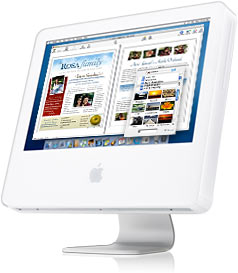From The Boston Globe Archives
[This article originally appeared at <<www.boston.com/dailyglobe2/098/business/Stunning_SuperDrive_puts_the_latest_Apple_iMac_over_the_top+.shtml>>, but is now only available for paid subscription members.]
 The best home computer has a sharp, attractive flat-panel display, an elegant off-white semispherical case, and a silver Apple logo. All very nice.
The best home computer has a sharp, attractive flat-panel display, an elegant off-white semispherical case, and a silver Apple logo. All very nice.But what puts this Apple iMac over the top is its CD burner, and the software that goes with it. It's called SuperDrive, it's produced for Apple by the Japanese electronics firm Pioneer, and there's not a lot it won't do. Of course it plays standard music CDs, but it burns them as well. And it also burns DVDs - the high-capacity disks that are becoming our favorite way to watch movies.
The SuperDrive iMac is priced at $1,899, $500 more than the cheapest model in Apple's low-price home computer line. But if you order one from Apple today, you'll be at the tail end of a two-week waiting list. The relatively well-heeled souls who favor Macs don't mind paying extra for quality, and for gearhead bragging rights.
After all, having a standard CD burner stopped being hip at least a year ago. They're on practically every new PC, and you can buy blank disks at Kmart, for heaven's sake. Where's the cool in that?
But DVD burning still has the rough-and-ready ambience of the wild frontier. For one thing, relatively few of us doing it; for another, there's still an ongoing bar fight over the underlying technical standards. You've got your DVD-R, your DVD-RW, your DVD-RAM, and so forth.
Apple settled on a drive that would use the DVD-R format, which is readable on standard home DVD players. Alas, a DVD-R disk can only be burned once. Apple decided against using the most popular rewritable format, DVD-RAM, because it isn't as compatible with standard DVD players.
Using burn-once disks makes perfect sense when burning CDs; each disk costs about 25 cents when bought in bulk. But DVD-R disks now cost at least 20 times as much - $5 apiece from Apple, and $8 to $10 at the typical computer store. On the other hand, each DVD disk holds up to 4.7 gigabytes of data - enough for a lifetime supply of MP3 music files, or a high-quality digital video of your family trip to Yosemite.
You don't have to buy a Mac to make your own DVDs. There are burners for PCs as well. But these tend to be aftermarket afterthoughts. There's a nice, well-made burner, and a jumble of photo- and video-editing software. None of it is especially well-integrated with the underlying Windows operating system, or with Microsoft Corp.'s pitiful Windows Movie Maker software. You can make it work, but it takes more than a little effort.
So it was with a drive we received from Vivastar USA Inc., a Swiss company with an office in Plainville. If all you want is a bigger, badder burner, the Vivastar does a fine job. It needed about half an hour to fry up 2.2 gigabytes of data. Even for PC users with no interest in creating home videos, the Vivistar DVD burner makes sense as a high-powered backup tool.
But an effort to burn a DVD video wasn't as successful. Everything seemed to work, and the video played fine on the PC. But it refused to run on other DVD players. A Vivistar spokesman suggested some changes to the software settings, and he might be on the right track.
But that's not the point. Amateur burners merely want to drag and drop, point and click. If the computer is so smart, it should figure out how to wind up with a playable DVD.
And that's why the SuperDrive iMac rules. The entire burning process, from start to finish, runs on greased rails. Just dumping the raw video from the camcorder to the hard drive is a simple matter of plugging in a Firewire cable and starting the built-in iMovie software. The images get dumped in, and you can edit, add titles, throw in a few gaudy special effects.
Click another mouse command, and your finished video is saved on the hard drive in DVD-compatible format. This takes a while - about half an hour for 15 minutes of video, longer if you do other computing tasks at the same time.
But once it's done, you slide in a blank DVD and start the Mac's iDVD software. In about an hour, you've got a finished DVD in your hand. One that'll work in any DVD player.
Apple users love to boast about the seamless integration between the hardware and software of the Mac. They often overstate the case, but not this time.
Anybody can hang a DVD burner onto a computer. But Apple's SuperDrive is truly built in, as integral a part of the computer as its keyboard, and almost as easy to use. It's the most desirable iMac yet; for digital media buffs, it's the best entry-level computer anywhere.
Hiawatha Bray can be reached at [email protected].